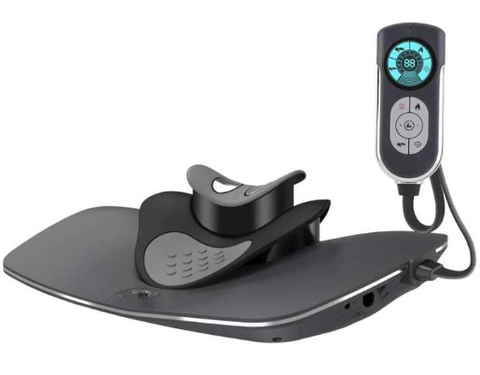Causation of Bone Spurs Directly Linked to Tech-neck, New Evidence Shows!
We might be developing a horn-like structure at the base of the skull from using smartphones.

Skulls of two male participants (28-years-old and 58-years-old) of the study by David Shahar & Mark G. L. Sayers.
The VertexTrax™ Cervical Traction Device is an all-in-one treatment system for neck pain relief. It's also known as cervical traction device, cervical stretcher, neck traction device, neck shoulder stretcher, best neck stretcher etc.

A study published in the journal, Scientific Reports, has suggested that our use of smartphones, tablets, and other hand-held devices is causing the growth of a horn-like bone structure at the back of the skull.
According to the study by Dr. David Shahar and Dr. Mark Sayers from the University of the Sunshine Coast in Queensland, Australia, the horn-like spikes are developing because of the forward tilt of the head, consistent with the use of smartphones. The tilt causes a shift of weight from the spine to the muscles at the back of the head. As a result, a new bone structure is developed to support the skull in this awkward position. The research seems to suggest that bones respond to tension and abrasion almost in the same way that skin does.

Until recently, the condition was thought to be extremely rare, that most in the medical research space thought there was no need to study the condition. More recently, however, there has been a surge of sitings of these horn-like bone protrusions also known as external occipital protuberances. Researchers like Dr. David Shahar believe that the condition is a recent phenomenon. In an article by the BBC, Dr. Shahar said “I have been a clinician for 20 years, and only in the last decade, increasingly I have been discovering that my patients have this growth on the skull.”

Dr. Shahar; the researcher behind the University of the Sunshine Coast study on external occipital protuberances. (Credit: Health Hub Chiropractic)
After noticing this disturbing pattern, Dr. Shahar and Dr. Sayers analyzed over a thousand X-rays of skulls from research participants between the age of 18 to 86 years old. The study revealed that the horn-like structure was actually more prevalent than they initially thought. More importantly, the spike was more common in participants between the ages of 18-30 years than in any other age group.

Dr. Shahar believes the condition is more prevalent in 18-30 year-olds because of the amount of time they spend on hand-held devices. He believes the hunched posture creates unnatural pressure at the intersection of the neck muscles and the skull. As a response, the skull then develops this protruding feature to provide a larger surface area to spread the pressure over.

The study has recently received criticism from the scientific community. Other scientists and practitioners are questioning the source and size of the sample used in the study as well as the logic behind drawing a link between the use of smartphones and the growth of the bone structure. Additionally, since the phenomenon had not previously drawn a lot of attention in the research community, some scientists believe there is no way of knowing how prevalent the phenomenon had been before the increase in interest.

That said, there is a recent surge of studies demonstrating the link between the use of hand-held devices and neck-related musculoskeletal conditions. That is cause for concern. For instance, a study by Yanfei Xie and her colleagues showed that neck-related musculoskeletal conditions amongst mobile and hand-held device users are 17.3–67% more prevalent than any other region of the spine.

Modern life puts too high a strain on our necks, this is especially true for younger people. Regardless of what we think of this research or the next, the fact still remains; we need to take better care of our necks.
